Church Forests in Ethiopia: Difficult Pieces of Sacred Greenery amid the Desert
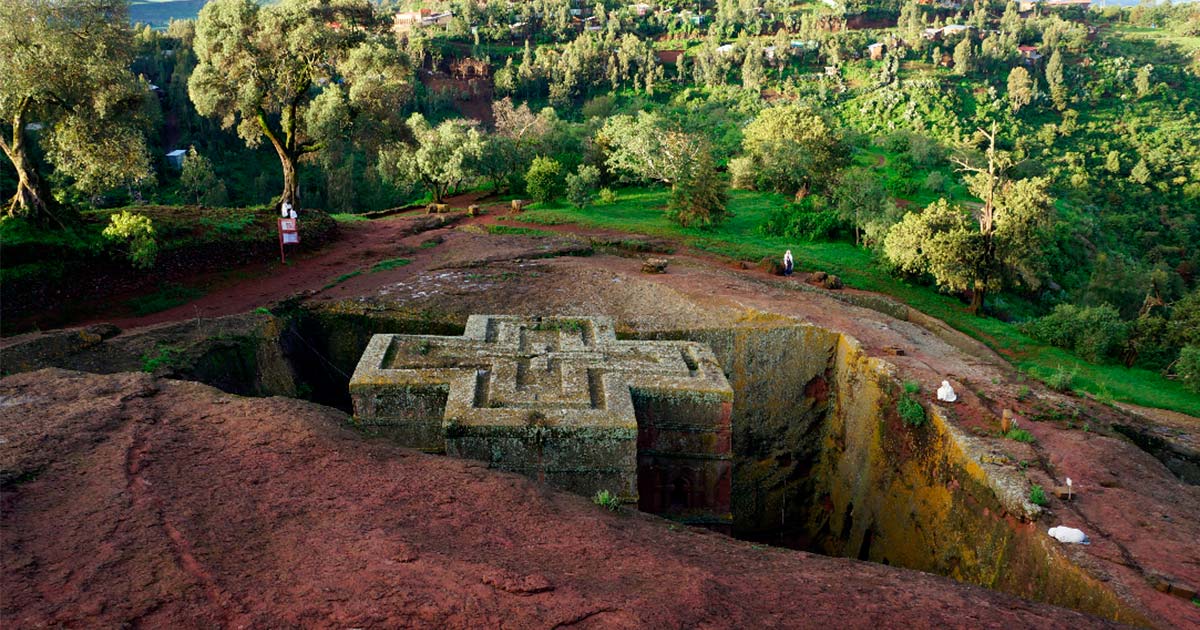
In the distant past, the world around us looked completely different in many ways. One notable aspect that changed is forestation. Once covered in lush forests, much of the world around us is now left barren. The same goes for Ethiopia, a rugged nation that was once abundant in forest lands. Its northern regions were once covered in lush forest but are now almost entirely deforested. Not all is lost, however, thanks to the Ethiopian Orthodox Tewahedo Church. Believing that their churches need to be surrounded by sacred groves and forests, the church leaders managed to preserve many precious ecosystems, which now dot the Northern Ethiopian countryside. Today, they are known as Ethiopian Church Forests.
A History of Sacred Beliefs and Ethiopian Church Forests
Ethiopian church forests, also referred to as sacred groves, are distinctive ecosystems unique to Ethiopia. Thanks to their one-of-a-kind nature, these groves possess notable cultural, ecological, and conservational significance. These forested areas are intimately linked with Ethiopian Orthodox Christianity and are typically situated in proximity to churches or monasteries. As such, they are a fundamental part of Ethiopian culture, and a major heritage of its people.
The origins of Ethiopian church forests can be traced back to ancient religious practices and cultural traditions that have evolved over centuries within this Northeast African country. Of course, these origins are closely linked to the appearance of Ethiopian Christianity, which itself dates back to the 4th century AD, when it was introduced to the region. The Ethiopian Orthodox Church has a long and rich history, and a unique character as well – blending indigenous beliefs and customs with Christian teachings. And here is where the church forests began forming. But how?
The secret is in monasticism, which was always an integral part of Ethiopian Orthodox Christianity. Monasteries were established in various regions, and a great many of them were surrounded by forests or created within forested areas. Monks sought solitude and seclusion in these forests to engage in prayer, meditation, and ascetic practices. And so it was that, in no time, forests and churches became closely linked together. But it also has to do with the deeply rooted indigenous Ethiopian beliefs. In traditional Ethiopian customs, natural spaces were considered sacred and inhabited by spirits. These beliefs influenced the integration of natural elements into religious practices. Church forests were seen as places where the divine and natural worlds intersected, making them ideal for spiritual contemplation and worship.
Sacred Groves of Peace and Holiness
We can see that the origins of Ethiopian church forests are deeply intertwined with the historical, cultural, and spiritual fabric of the country. The people recognize this importance, and play a crucial role in the preservation and management of these forests. The traditions and practices associated with these sacred groves have been passed down through generations, creating a sense of ownership and shared responsibility among community members. This gives the forests a unique aspect: they brought the Ethiopian people closer together. Church leaders and communities both understood that protecting the forests around their religious sites was not only a sacred duty but also essential for the sustainability of their shared communities. By preserving the forests, they preserved their faith, and in turn – their country.
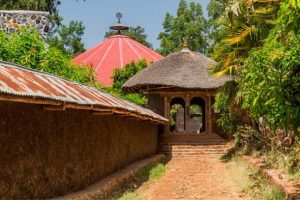
Ethiopian church forest Ura Kidane Meret (Mihret) monastery at Zege peninsula in Tana Lake. (Matyas Rehak/Adobe Stock)
Another great feature about these forests is the preservation of small and unique ecosystems. Church forests are recognized as incredible biodiversity hotspots, harboring a wide array of plant and animal species. They serve as refuges for endemic and endangered species, including several rare and threatened birds, mammals, reptiles, and insects. The forests often act as corridors connecting fragmented habitats. In a way, they “repair” the damage done by deforestation, preserving what little could be preserved. Thanks to all this, the Northern Ethiopian region is characterized by exceptionally high levels of species richness and a significant number of endemic species, meaning they are found nowhere else on Earth.
Biodiversity hotspots were first identified and defined by British ecologist Norman Myers in 1988. To be considered a hotspot, an area must meet two main criteria: It must have at least 1,500 endemic plant species, which is a measure of its species richness, and it must have lost at least 70% of its original habitat due to human activities. This area of Africa, sadly, suffered greatly at the industrious hands of man, and was nearly lost. But thanks to these sacred groves, hope still remains for the maintaining of vibrant life. The value is particularly placed on trees, as the Ethiopian church forests are known for their rich tree diversity. They contain a high number of endemic and native tree species, some of which are rare and have medicinal or cultural uses.
A Key Aspect of Ethiopian Heritage
There is also a lot of symbolism related to these church forests. In an area that is predominantly arid, semi-desert, hot, and rugged, you can step into these small oases of beauty, shade, and greenery, where everything is peaceful, and the birds sing in unison. Many have linked the shift in environments as going from “hell to heaven”. It is the perfect link between nature and spirituality, and a way for Ethiopian monasticism to survive in its original form – throughout the centuries. And even so, some churches are not on land. The Entos Eyesus church, for example, is situated on a tiny island in the middle of Lake Tana. The whole small islet is covered in lush forests.
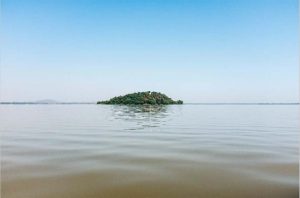
Lake Tana, Ethiopia. Glen/Adobe Stock
Sadly, these sacred groves are always under threat, and that threat is of complete disappearance. Their fate is endangered by many things, including agricultural expansion, logging, population growth, and urbanization. The encroachment of human activities puts pressure on the forests and their fragile ecosystems. Ethiopia goes in tune with the modern world, and the narrative of the modern world is continued destruction of everything.
Luckily, various conservation initiatives have been undertaken to protect these forests, involving local communities, religious institutions, and governmental and non-governmental organizations.
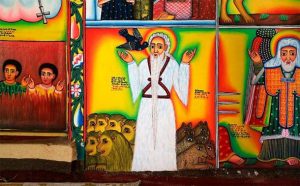
Murals at Entos Eyesu Monastery (Sailko/CC BY 3.0)
The rest of the world, too, casts a glance towards this corner of the world, understanding that preservation of these groves is vital to stave off the desertification of entire Ethiopia. Christ of Mauch, director of the Rachel Carson Center for Environment and Society at the University of Munich, Germany, says that, “It’s a remote part of the world, where the natural environment has become part of the spiritual environment. It is culturally, as well as scientifically, important to save these pockets of forests.”
A True Oasis Within a Desert
Alemayehu Wassie, a leading Ethiopian ecologist, has been an instrumental figure in the preservation and studying of these small ecosystems. For more than 10 years he has been devoted to keeping sacred forests alive and in the spotlight. Recognizing that the tropical dry forests are among the most exploited forest ecosystems of the world and have been increasingly fragmented, Wassie urges for increased levels of protection. He writes:
“Dry Afromontane forests of Ethiopia have faced vast exploitation and almost all of these forests have been converted to agricultural lands, except for small fragments that are left in the most inaccessible areas or around churches (“Church forests”). The disappearance of the forests has been most drastic during the past 100 years. In the beginning of the 1900s, the forested area of the country was estimated at about 40% but now downscaled to 4.2 % of the land area. However, the small, isolated patches of natural forest stands occurring around more than 30,000 churches still persist in a degraded landscape and might contribute to restoration, biodiversity conservation and provide many other economic and social benefits. The effectiveness of these church forests to provide “ecosystem services” for the landscape and serve as ‘stepping stones’ for restoration will depend on their long-term sustainability.”
Wassie engaged in several campaigns in hopes to educate both the people and the clergy about the threats their groves are facing, and how they can help preserve them. He points out that cattle are a major threat to the woods, as they enter on their own to graze. By doing so, they eat the young saplings and prevent further growth in the forests. In order to counter this, Wassie urged for the creation of stone walls that would keep the cattle out. He also offers cash donations to churches that manage to build this form of protection. To date, 15 or so churches have constructed a series of walls. And some priests have even taken on the role of stewards of their forests and encouraged local people to help build these conservation walls. Many now volunteer time to remove stones from fields for construction, which is also good for crop yields. It is a true win-win situation.
Preserving Ethiopian Heritage
Ultimately, the heritage and importance of the Ethiopian Church Forests cannot be denied. In many ways, they preserved the fiber of Ethiopian identity throughout the centuries, serving as sanctuaries for spiritual retreats, offering solitude, tranquility, and a connection with nature. Monks, nuns, and religious practitioners would seek these forests for prayer, meditation, contemplation, and ascetic practices. The groves did not allow the Ethiopian Orthodox Christianity to succumb to outside pressures.
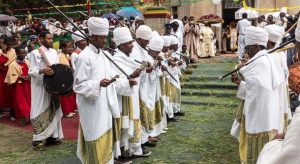
Orthodox Christian priests dancing in front of Saint Mary church for Timkat in Addis Ababa, Ethiopia. (Jean Rebiffé/CC BY 4.0)
What is more, the Ethiopian church forests are often associated with cultural practices and festivals. These forests serve as gathering spaces for religious ceremonies, processions, and celebrations. Festivals such as Timkat (Epiphany) and Meskel (Finding of the True Cross) are often held near church forests, attracting large numbers of participants. Also, the groves are often associated with oral traditions and legends passed down through generations of Ethiopians. These stories narrate the spiritual significance of specific trees, lakes, or caves within the forests, highlighting the cultural and historical heritage associated with these natural spaces.
The Heritage of the World
Alas, education is still not adequate in this part of Africa, and this prevents full conservation of the groves. The church owns these groves, and scientists often need permission to study the plants and conduct conservation. If only the people and the clergy would have better education and knowledge of the preservation methods, things would be much better for their sacred groves.
But even so, everyone has a shared understanding of how important these groves are for everyone. After all, these forests represent an integral part of Ethiopia’s cultural landscape, providing a tangible connection between spirituality, nature, and community. Preserving and celebrating this heritage is essential for safeguarding the cultural and ecological legacy of Ethiopian church forests for future generations.